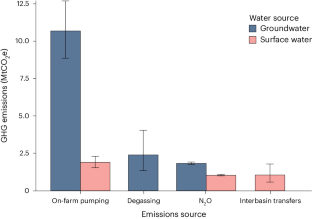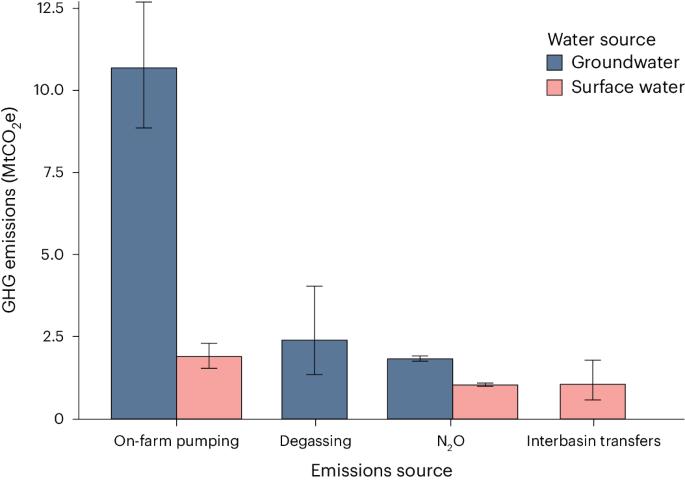Hotspots of irrigation-related US greenhouse gas emissions from multiple sources
引用次数: 0
Abstract
Irrigation effectively increases yields and buffers against intensifying climatic stressors to crop productivity but also produces greenhouse gas (GHG) emissions through several pathways including energy use for pumping (on farm and for interbasin water transfers), N2O emissions from increased denitrification under elevated soil moisture, and degassing of groundwater supersaturated in CO2. Despite irrigation’s climate adaptation potential, associated GHG emissions remain unquantified. Here we conduct a comprehensive, county-level assessment of US GHG emissions from these irrigation-related pathways, estimating that irrigation produces 18.9 MtCO2e annually (95% confidence interval 15.2–23.5 Mt), with 12.6 Mt from on-farm pumping, 1.1 Mt from pumping for interbasin transfers, 2.9 Mt from elevated N2O and 2.4 Mt from groundwater degassing. These emissions are highly spatially concentrated, revealing opportunities for geographically targeted and source-specific GHG mitigation actions. These findings enable strategic consideration of GHG emissions in decision-making associated with irrigation expansion for climate adaptation. Despite its utility for climate change adaptation, US irrigation produces 18.9 MtCO2e yr−1 from groundwater degassing, elevated N2O and energy use. This county-level analysis reveals opportunities for geographically targeted emissions mitigation.


与灌溉相关的美国温室气体多源排放热点
灌溉可有效提高产量,缓冲气候对作物生产率造成的日益加剧的压力,但也会通过多种途径产生温室气体(GHG)排放,包括抽水(农田抽水和流域间调水)的能源消耗、土壤水分升高导致的反硝化作用增加所产生的一氧化二氮排放,以及二氧化碳过饱和地下水的脱气。尽管灌溉具有气候适应潜力,但相关的温室气体排放仍未量化。在此,我们对这些灌溉相关途径产生的美国温室气体排放进行了全面的县级评估,估计灌溉每年产生 1890 万吨 CO2e(95% 置信区间为 15.2-23.5 万吨),其中 1260 万吨来自农场抽水,110 万吨来自流域间调水,290 万吨来自 N2O 升高,240 万吨来自地下水脱气。这些排放在空间上高度集中,揭示了采取有地理针对性和特定来源的温室气体减排行动的机会。这些发现有助于在与扩大灌溉以适应气候相关的决策中对温室气体排放进行战略性考虑。
本文章由计算机程序翻译,如有差异,请以英文原文为准。
求助全文
约1分钟内获得全文
求助全文

 求助内容:
求助内容: 应助结果提醒方式:
应助结果提醒方式:


